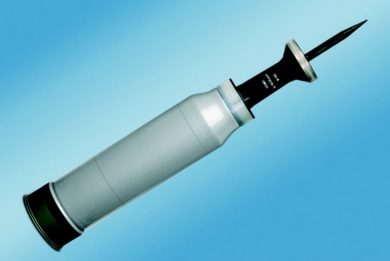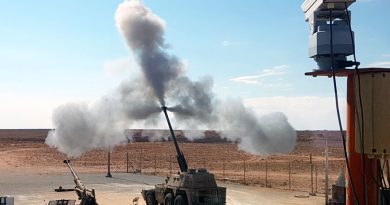Rheinnmetall presents its new SSW40 grenade launcher
In a demonstration organised on the company Unterlüß proving ground, Rheinmetall presented live its new SSW40 automatic shoulder fired grenade launcher, the acronym standing for Squad Support Weapon, the number indicating the calibre, 40 mm
In the past Rheinmetall developed a 40 mm Medium Velocity (MV) grenade launcher system that comprised ammunition and launchers. The grenades, derived from high velocity 40 mm rounds, featured high modularity and were to be fitted with a point detonation (HEDP) or airburst (ABM) warheads. Their time-to-target at 200 metres was less than 2 seconds, the flatter trajectory ensuring increased accuracy and first-hit probability. A single shot grenade launcher, designed to be used stand-alone or fitted under the barrel of an assault rifle, called Cerberus, was designed, its semi-automatic counterpart being the Hydra, which could fire only MV ammo. Heavy and cumbersome, these Rheinmetall Waffe Munition (RWM) developments remained mostly at prototype stage, however they allowed the company to acquire considerable experience and know-how, which were put to fruition in new developments.
Most recently, a new system was developed, which includes the SSW40 (for Squad Support Weapon), an automatic shoulder weapon capable to fire both LV and MV 40 mm grenades, and a new family of MV grenades. “Our target was to develop a weapon with the size and mass of an assault rifle,” Head of Portfolio Infantry at RWM told EDR On-Line. The result was a grenade launcher that is 800 mm long, 70 mm wide and 400 mm high (with the 5-round magazine) and has a mass of 4 kg empty.
The key element in the SSW40 is the hydropneumatic self-regulating dampening system, which not only reduces the recoil impulse to acceptable levels when firing MV grenades, but also allows firing LV grenades, without requiring any action from the shooter, as it adapts to the impulse generated by the round, ensuring case ejection and self-loading of the next round. How this is obtained remains of course company-classified! No figures were provided on the recoil energy, however RWM Head of Portfolio Infantry told EDR On-Line that “when firing an MV round the peak impulse is lower than that of a Low Velocity (LV) round in a standard grenade launcher, while that of an LV round is almost nil.” It is the recoil damping system that allowed to reduce as much as possible the launcher mass, as without it a much heavier system would have been needed to reduce the impulse.
The case ejection port is located over the magazine, a completely different solution compared to the Hydra prototype. The SSW40 has a further peculiarity; it features a break-barrel that allows using special purpose ammunition, which are typically longer than standard 40×46 mm rounds. The around 300 mm long rifled barrel is hinged in its rear-low part and rotates downwards, which allows easy loading and unloading without risking dropping the round, as you do in a shogun, a helpful feature also in case of stoppage. To rotate the barrel a catch is available in front of the magazine housing.
When loading a new magazine, to cock the weapon the operator pulls back the stock, allows the round to align with the chamber, and pushes it forward. The adjustable trigger is located on top front of the handgrip, while the safety lever located in the lower part of the receiver and can be easily reached with the firing hand.
The SSW40 is defined as “automatic”, which is correct as the new grenade launcher can be developed in full-auto mode. However, the current model is semi-automatic, the safety lever having three positions: safe, semi-auto, and magazine release. “The levers can be customised according to users’ will. We can split the functions, having for example a dedicated switch for magazine release,” RWM´s Head of Portfolio Infantry points out. All SSW40 commands are ambidextrous.
As said, the SSW40 will be available also in a full-automatic version. This will have a firing rate of 300 rounds per minute, which means that in one second a whole 5-round magazine will be emptied, 3- and 4-round magazines being also available. RWM is developing an auto-feeder that will allow the SSW40 to fire 40 mm grenades from a container, which would perfectly fit the full-auto version. This should be used for firing from static positions, a bipod can be fitted to the weapon, or from a pintle mount on a vehicle, the SSW40 maintaining the capability to fire from the magazine, quickly switching back from an ultra-light grenade machine gun use to its original infantry shoulder fired role. Considering its use among the infantry squad, one or two rounds are considered sufficient to convince the enemy to keep his head down.
According to Rheinmetall, maximum range using MV rounds is 900 metres. “This number is what comes out when considering theoretical ballistic calculations in optimal conditions, however we already fired well over 800 metres during the first trials,” RWM told us, adding that “for most customers the average fighting distance is 200 to 300 metres.”
This brings us to the sight issue. MV rounds under development at RWM have a muzzle velocity of around 120 m/s, over 50% more than a standard LV grenade; this means that at 200-300 metres the trajectory is much flatter than that of an LV grenade, which makes aiming much easier, and as time of flight is reduced, also cross wind influence is much lesser. “At those distances when using MV rounds you don’t need a ballistic compensator, which becomes of use when range increases,” the RWM representative told EDR On-Line. The SSW40 is optic agnostic, and for standard use red dot sights eventually coupled to simple mechanical compensators are well sufficient.
This changes when airburst munitions are used. RWM is developing a family of MV rounds, which common characteristics are: a 226 grams projectile, a 120 m/s muzzle velocity, a 900 metres maximum range, a recoil impulse of less than 30 Ns, a penetration of over 70 mm of rolled homogenous armour, a no arm distance of more than 18 metres, an all arm distance of less than 36 metres, and a self-destruction time of 14±1 seconds. “During the initial qualification phase we could verify that fragmentation and armour penetration are at the same level of high velocity rounds, lethal radius for HE being around 10 metres,” RWM said.
Let see what RWM is developing in the MV ammo field, and the status of the various rounds. The first to be developed were training rounds, which are already available in four versions, Training Practice (TP), Training Practice Tracer (TP-T), Training Practice Marker (TPM) and Training Practice Marker-Tracer (TPM-T). These have the same impulse and ballistic characteristics of live rounds. Next ones to be available are 40 mm Warshot Point Detonating (PD) rounds; here too four types will be produced, High Explosive (HE), High Explosive-Tracer (HE-T), High Explosive Dual Purpose (HEDP) and High Explosive Dual Purpose-Tracer (HEDP-T). Their development is pretty advanced, and they should reach full qualification by year end. The same four types but fitted with a time/point detonation fuse providing the airburst effect are under development and should follow the PD family in Q1/26. Last but not least come special rounds, such as illumination, smoke, sound and flash, door breach, CS gas, and impulse marker. All those ammunitions are produced at the RWM plant in Unterlüß, while fuses come from RWM Zaugg, based in Lohn-Ammannsegg, Switzerland, and the propulsion element from the RWM plant in Trittau.
When using airburst ammunition basic sights and compensators will not be sufficient. A fire control system (FCS) and a programming unit are needed, Rheinmetall obviously proposing its TacRay FCS. A light and compact system, the TacRay has a mass of only 315 grams with battery and mount, its dimensions being 130 x 50 x 80 mm; it is IP 68 waterproof and it can stay in water at 1 metre depth for 2 hours. It contains a ballistic computer, meteorological sensors for pressure, humidity and temperature, an inclinometer, a compass, and an eye-safe laser rangefinder capable to measure distances up to 2.5 km. It also features a visible sighting laser, an IR laser, and an IR illuminator. The operator can see the scene on an OLED display, where he can read the target distance as well as the required number of clicks to adjust the sight.
Target distance is transformed in flight time, this data being fed into the IR-Programming Unit (IR-PU), which sends an infrared signal to the back of the round while this leaves the barrel, providing the delay after which the round will detonate, for example when overflying an enemy trench.
As in the case of normal sights, here too the SSW40 is FCS-agnostic, while the RWM IR-PU is used in combination with RWM airburst rounds.
RWM rounds are being specifically designed to obtain best performances from the SSW40, however all types of MV and LV rounds can be used. As for special rounds, the new Rheinmetall grenade launcher can be used to launch a variety of ammunition such as reconnaissance UAS, loitering munitions, missiles, and rockets, providing the impulse falls in the MV rounds limits.
Several SSW40 were produced for qualification purposes; the process is currently in progress and will require firing between 15,000 and 20,000 rounds. “We are planning to complete development and reach full qualification before year end, if all goes well,” RWM said. However, as all safety hurdles were overcome, the company could let potential users and media trial in person the new weapon on its proving ground, although the grenade launchers seen at Unterlüß were not yet fitted with the air burst kit, this capacity being still in the last phase of development. Rheinmetall is now able to issue specimen to potential users for trials, production being scheduled to start in 2026.
Photos courtesy Rheinmetall and P. Valpolini









